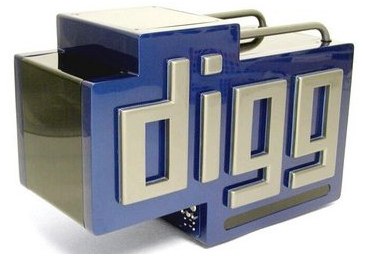
*Due to the sheer length of this article and for your convenience, I have turned this blog into a downloadable PDF document (30+ pages) that can be found at the end of this post. Please contact me if you have any issues downloading it.
If you know anything about social media, I am sure you have heard of the social news site digg.com. Over the years digg.com has become the premier social news/bookmarking site on the Internet in the social media/web 2.0 niche.
The website itself generates over 30 million unique visitors per month, and articles that make it to the digg front page can generate anywhere from 10,000 to over 400,000+ or more views in a matter of a 24 hour to 30 day period.
Every single day content, ranging from pictures to news articles to funny and interesting videos, is just a small sampling of the content that hits the digg front page. The website properties that do make it to the popular front page range from obscure blogs to sites we all know such as cnn.com.
Loyal digg users use the site in a myriad of ways, but one thing is for sure: most diggers use it and visit it often is because they get news that is relevant and also see what is popular on the web at any given time.
If you are new to how digg works, it is relatively simple…
The digg community, who all have profiles on the site, find the best/funniest/most interesting/bizarre/timely news or content and submit it into the site to be voted on. The content that has been submitted goes into the “upcoming section” and is organized by category.
Based on the amount of votes that the piece or content or article gets from the users of the site digging it (voting it) determines if it is worthy enough to hit the digg front page of the website or not. Pages are promoted to the front page from the upcoming section by way of a top secret algorithm that digg has never shared and probably never plans to share with anyone…as it is always changing and being reworked over time.
As someone who has successfully leveraged digg to drive massive traffic through websites and pieces of content (70+ as of writing this article), it is my hope that you find this guide extremely helpful in helping you get your and others’ pieces of content to the front page of this site to leverage for you and your company’s personal gain.
This guide will be perfect for you if you don’t want to have to pay someone thousands of dollars to teach you how to fully leverage this site. While parts are somewhat complex, I feel I have done a good job at keeping it as simple as possible for you to follow.
This guide is broken down into five sections, and I encourage you to take it each section at a time, part by part.
I have written this guide in a specific way on purpose so you get the most out of it. And to ensure that you get the most out of it, I recommend that you don’t skip ahead.
One last piece of information that I would like to provide you is…
For confidentiality reasons I will not be referencing anything that can be connected to my digg profile in this guide itself, but if you wanted to know how to find me on the site or in other social media sites in general, I can be easily found through facebook or twitter; just send me a message and I will be happy give you the link to my profile.
You can find me on facebook and through twitter.
Let’s get started shall we!
Part 1: The Setup + The Community + Understanding The Moving Parts
Why Getting To The Front Page of Digg Is So Awesome
First things first! Getting to the front page of digg is flat out amazingly awesome. There are three reasons for this.
1. Traffic
2. Backlinks
3. Rolling Viral Social Media Exposure
Traffic
Getting to the front page of digg.com is extremely powerful because the initial traffic spike that is sent through your website is something that very few bloggers or website owners ever get to experience over their career as an entrepreneur or webmaster.
Pieces of content that hit from personal experience have gotten anywhere from 10,000 to over 400,000+ visits in a 24hr to 30 day period for me, and as they were happening it was totally amazing seeing how it unfolded right before my eyes as I anxiously sat over my google analytics refreshing once every 30 seconds.
If you want to know the piece of content that got that amount of exposure, please just drop me a line on facebook or twitter.
The bottom line is this…the traffic that is generated from digg causes a myriad of positive things all at once, which leads me to my next point.
Back Links
When your site or piece of content hits the front page of digg the initial traffic spike is one benefit, but another completely separate benefit to your site or blog hitting is the amount of instantaneous backlinks that automatically link to your site after it is promoted to the home page.
These backlinks create amazing SEO juice for the article or piece of content, and build what I like to call “domain equity” for the site.
From personal experience something that hit the front page for me generated over 800+ backlinks in a matter of 30 days. For specific keywords right now it is the number one listing on google for the specific phrase. If you want to know which one it is, just contact me on facebook or twitter, and I will share it with you.
Now with all of the backlinks that are generated, this creates a third added benefit to getting your article hitting the front page…which is what I like to call “Rolling Viral Social Media Exposure.”
Rolling Viral Social Media Exposure
You may have heard this phrase and probably thought…: “What the heck do you mean?”
Well think about it this way…
When that initial traffic spike happens from having your article on the front page of digg.com, and when having your article getting links to other sites that automatically link on the web, and with other blogs and websites manually linking to your piece of content…something powerful happens.
You see one thing you must understand as a social media marketer and website or blog owner is that each and every person more often than not has a twitter and facebook account. They may have other accounts, for instance StumbleUpon, but these two are the most well known.
You see, the reason this is important is because with all the initial traffic being generated from the initial spike on the digg.com homepage as illustrated above, the users that come to the website initially have a choice to share it with their twitter followers or facebook friends. If they do, and the continual viral word of mouth passing of the link around happens…this is what generates more viral exposure for you, and more backlinks as a result.
Seeing this play out in the analytics is really interesting, and coming up I will show you exactly how this plays out by pulling the screen shot from my google analytics.
What Exactly Happens When Content Hits The Front Page?
When a piece of content hits the front page, a chain of events instantaneously happen, and if you are lucky, and the content is what the community likes and wants other to see, there are backend benefits that come with hitting a homerun on digg that we will get into later in this guide. For now, I will just share with you what happens at the first part.
When you hit the front page of digg with a piece of content, here is the flow of what happens.
I. Article is promoted to front page
II. Initial traffic from digg front page increases
III. Article is automatically pulled to what are called “aggregation sites”
IV. As traffic builds people begin sharing it with Twitter + Facebook Friends
V. If you are lucky it is passed around by people through e-mail or instant messaging
VI. If you are even luckier it is talked about by a blogger or vlogger and they give you a direct link
VII. If you are even luckier the link or piece of content is linked on a massive news/content site with the direct link to your page creating even more traffic.
VIII. If you are even luckier your piece of content ends up on smaller social bookmarking sites and gets promoted to their front pages creating even more traffic and exposure to you and your site
IX. If you are even luckier your piece of content ends up on the top in 24 hours, top in 7 days, top in 30 days, and top in 365 days within the digg.com website
Basically to sum it up in six words…
“You Lose Control Of The Content”
As the process continues and more votes are added to the piece of content, more and more traffic is generated, and what you must understand is that any one of those roman numerals above can happen to varying degrees based on the quality of the content and the relevancy to site owners who link to it/share it or not. There is no exact path that the piece of content takes, all you have to understand is that once it is there…there is nothing you can do about it…you just have to watch the movie, and not try to direct it.
Here is a screen shot of the traffic sources from the biggest homerun one of my sites ever hit on digg…Just a slight disclaimer…these results are NOT typical. (This was over a 30-day period and only includes the top 12 sources. There were well over 2,800+ sources where the traffic came from).
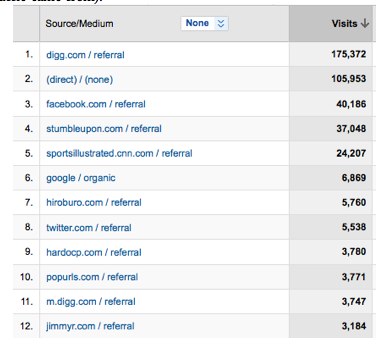
SPECIAL NOTE: This site is still getting about 2,000+ visits per month on autopilot since hitting the front page of digg as of this writing without me doing a thing.
If you notice here from this graph, as I illustrated from above in the roman numeral section the initial traffic spike from digg fueled other social media traffic as well.
The digg spike fueled facebook, twitter, stumbleupon and also people sharing the direct link through e-mail.
The places towards the bottom…most notably popurls.com and jimmyr.com, these are the content aggregation sites that instantly link to your site once it hits the front page of digg.
As you can also see, this page was linked on a sports illustrated site, and the amount of google organic traffic of people searching it increased through the roof!
While this is a total homerun, this kind of traffic being generated through your site using digg.com is definitely possible…but it relies on many random things lining up all at once.
Let’s talk about some of the statistics and more about the site now and how you can effectively get started shall we!
The Key Statistics For Every Digger In Their Profile
Below is a screen shot of someone’s profile on digg who is a power user.
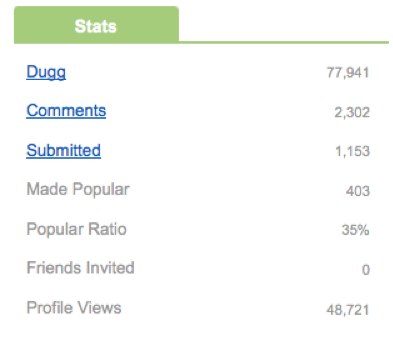
When you register for a profile on digg this information will be at the bottom right-hand corner of your and every other digger’s profile on the site.
If you have trouble finding your profile you can go to the link that looks like this:
Digg.com/users/YOURUSERNAME to get to the page
The “Dugg” line shows how many stories a particular user has dugg, or in other words voted, by pushing the “digg button” on the site.
The “Comments” line shows how many comments a digger has left on a story that is promoted or not promoted to the front page.
The “Submitted” line shows how many stories the digger has submitted into the site after finding the links on the internet, or from a friend sharing them.
The “Made Popular” line keeps track of the # amount of front page stories a digger has made popular over the entire life of their profile being on the site.
The “Popular Ratio” is calculated by taking the (Stories Made Popular / Stories Submitted) to get the popular ratio percentage.
The “Friends Invited” line is something that I have never understood why it was put there, but I guess digg just hasn’t taken it down yet.
The “Profile Views” line is a statistic that shows how many times this person’s profile has been viewed. Obviously the more articles you get to the front page, the more your profile is viewed.
The Lingo For Digg
Just to keep things step-by-step as you continually work through this guide, let’s just go over some lingo that all diggers share and use on the site.
This is a screen shot of what a story looks like on digg once it has been submitted, and will cover our first two terms.

Digg – A digg is when you press the digg button. In the case of the story above, if you hit the digg button, the number would change to 64 diggs.
Bury – A bury is something that has been integrated onto the site for users to get rid of spam. If a story gets enough buries, it will never get to the front page…and conversely if it hits the front page and also gets a lot of buries, it won’t stay on the front page. Pretty much the bury button is what is used to help monitor spam on the site and relies on the users to determine what stays on the front page, and what is taken off or never makes it to the front page.
Some notes before moving on…
- I rarely if ever use the bury button
- If you notice, you can tweet the article or share the article using facebook by pushing the two buttons next to the pictures.
- You can also e-mail the article to a friend conveniently by pressing the envelope.
- Also note that you will always see the story’s domain right under the headline. As you can see mashable.com was the source for this article.
Now here are two screen shots of another part of digg’s site that will cover our next two terms before moving on.
To find this part of the site, you click to a person’s profile, and then press the tab that says “Friends’ Activity”

Friend – A friend on digg is someone who you follow all of their stories and submissions, whether they are a friend of yours or not.
Fan – A fan on digg is someone who is following you, and you may or may not be following them. The more friends and fans you have on the site, the greater influence you have over the chances you will get your stuff to the front page…but more on that later.
Below is a final screen shot that will cover the final term before moving onto the next section.

Mutual Friend – A mutual friend is someone who you added as a friend, and they added you as a friend. You both can see what you both submit into the digg.com website.
Now as I am methodically going through all of these moving parts of the site trust me all of this will come clear later. If you are getting discouraged, please stay with me.
What You Need In Your Site To Handle The Traffic and Exposure
To ensure that your site or your friend’s site can handle the traffic, they must have two very important things in place.
- Reliable Hosting – If your site isn’t hosted by a reliable host that can handle the load the traffic will put on the site, your site will hit the front page, and then be buried relatively quickly because the site won’t be able to be pulled up.
- WP-Cache WordPress Plugin – If you are a blog, this plugin is absolutely essential because it allows your pages to load faster when you get sudden surges of traffic.
The Specific Sites You Need To Know and Be Familiar With
- Socialblade.com – This site will serve many purposes, but most importantly this will track the amount of diggs your personal profile will have as you become active in the community. For every profile on digg, you can only make a certain number of diggs per 24 hours. Socialblade helps you monitor this as well as all of the stats for your personal stories that hit the front page, as well as every other story that makes it popular on the front page. We will get more into this later. For now just keep the site in mind so when I mention it later you will remember it.
- FriendStatistics.com – This site will serve the main purpose of managing your list of friends, fans and mutual friends. As you will begin to discover, this will be the tool that becomes your best friend as you push stuff to the front page like clockwork!
- Di66.net – This site helps you monitor and see what is going on in digg on a higher level than social blade. If you go to the site and explore around you will see what I mean. It features top users that are getting stuff to the front page and also breaks down specific parts of the site in regards to the domains that are hitting the front page and much, much more.
- Biggboard.brainnovate.com – This site will help you track stories in real time after you have submitted them into digg. It is a great way to track stories because it automatically updates, and it is easy to read and follow when you are waiting for the story to pop to the home page of digg.com.
Part 2: Laying The Groundwork
After you understand all of the moving parts to the site, along with the other tools that you will need to use and leverage to successfully get your content to the front page, it is time to take action, and start building your profile!
The Exact Process of Building an Influential Profile on Digg.com
Step 1: Go to digg.com, and set up your profile
Things to keep in mind when setting up your digg.com profile…
- Don’t make your profile name your personal name – You want to make your profile a brand that stands out and is memorable. Be sure to have an icon for an image in mind and a short but catchy name that the digg community will remember over time.
- If you need help with ideas for names and/or icons, feel free to see some of the users that are getting to the home page and customize your profile to your liking. Just keep this very first point in mind that you are building a brand outside of yourself.
- Be sure to put your personal screen name in there for AIM as this will become an important part to the equation a little later.
SIDENOTE: Why you shouldn’t use your name when starting your digg profile…
It is important to realize that you shouldn’t use your personal name when creating your digg profile because…
In the future if you want to submit your own personal site, the digg community won’t like you for it. Building a brand with your profile brand instead of your personal name keeps you somewhat anonymous and allows you to fully leverage the site without your personal persona getting involved.
When you start networking with the users who connect with you, they will eventually find out, but don’t be alarmed. There is a very high chance that they are doing the same thing themselves with their sites and digg profiles as well.
Step 2: Go to SocialBlade.com/digg/topusers and add 80-100 of the top users who are the most active and are getting the most digg front page stories.
The fact is this…you want to add friends and contacts on the site that are going to be active and be on top of your future websites you submit to digg. With the top diggers being a community that believes “I digg you, you digg me,” it only makes sense to add friends to your digg network that will return the favor after you help them.
Another fact is that the majority of the links that are submitted into the digg.com website don’t stand a chance of getting to the front page for the reason that the majority of the users are not even aware of exactly what they need to do to be successful in getting something promoted to the front page of the site.
Each and every day anywhere from 130 to 140 pages are promoted to the front page of the site, which illustrates why building a solid digg network from the start is the most important part to starting out on the site if you want to legitimately leverage it for traffic, backlinks and effective exposure.
After you go to socialblade.com/digg/topusers and add anywhere from 80-100 new active diggers, then the commitment to building your profile begins.
SIDENOTE: Once you add these people to your profile on digg, they will get an e-mail saying that you added them. Most of them don’t add you back as a friend until you prove your loyalty to them, which we will get into a little later in the guide.
As you continue to build momentum with your profile, which involves the next steps I will get into, it is important to realize that for you to be successful on digg you must always be active and present in the community on a daily basis (1 hour to 1:20 per day). Not only does this activity help you build your brand on the site, but more so by showing others you are active and involved helps you in the long run for making strategic connections + getting more out of the site.
If you just treat this site as a “content dump” and a “lottery”, the site will treat you and your content as such. Being a part of the community is essential, and staying active by commenting on articles + networking with other diggers is part of building a powerful digg profile that will get you results every time.
I will boil it down to a simple equation for you…
Engagement In Community + Building Digg Influence (fans + mutuals) + Networking With Diggers (Phone + IM) + Becoming Well Known + Submitting High Quality Content (your own or other’s)
=
Massive Digg Success + Many Many Digg Front Page Stories + Tons of Traffic + Tons of Backlinks + Tons of Social Media Credibility
***STOP***
Before I go any further…I want to give you a fair warning before I go into the detailed process of building your digg profile because it is from this point forward that most people drop the ball, and wonder why they aren’t getting results. The fact is that if you really want to leverage digg and build a powerful profile that gets stories promoted to the front page, it is going to take you personally anywhere from 1-1.5 hours per day every single day. It will be in 20 and 30 minute blocks of time, 2-3 times throughout the day, so don’t think it will be all at once. If you aren’t willing to commit to this daily activity commitment necessary to be successful using digg, you shouldn’t read the rest of this guide.
************
Ok, so now that we have that out of the way that leads us to step 3…
Step 3: The exact daily activities you need to take part in to build a successful profile on digg.
Digging Friends + Mutual Friends Submissions
After building your profile and after adding your initial 80-100 friends on digg this is where the fun activity begins. The secret thing you need to know here is that for your new friends that you added to add you back, you first have to show them you loyally care about their submissions by staying on top of them and digging each and every one they submit into the site.
Here is the process on how to do this easily.
What you need to do is first login to the site.

Next step is to go to your “friends activity”

Now this is where some of you may screw up…You can’t forget to hit the submission button on the right side, or else you will just be digging stories that your friends are digging, instead of your friends’ personal submissions.
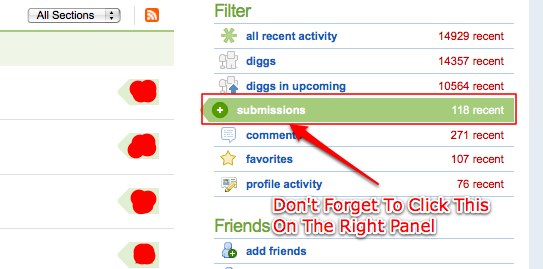
This is what you should see after you follow these steps. If you don’t see this page. Start back up at the top of these directions and go through them again. If you have any problems, simply contact me, and I will help you clear it up.
This is what you should see…

Now this place on digg is where you will be spending the majority of your time each and every day as you build your digg profile and influence.
Here is what you need to do to digg your friends’ submissions so you stay on top of them like a hawk…
Click the first story in the list…
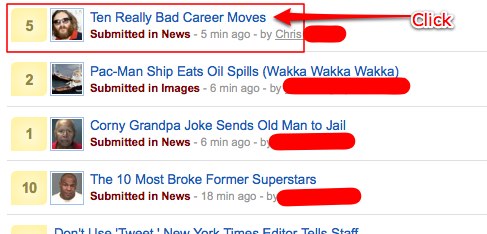
As you can see, this story was submitted by my friend Chris, and it was submitted 6 minutes ago.
This will bring you to this page as seen here, and here is what you have to do to digg (vote) the submission…
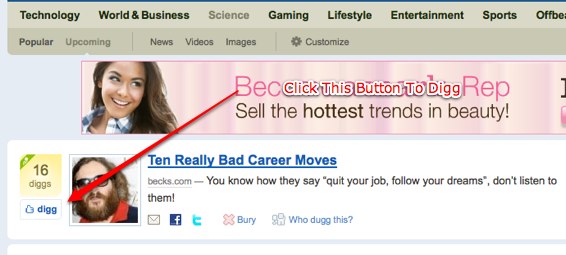
Then after doing that, you press the “back button” on your browser, and do the same process again for the story below it.
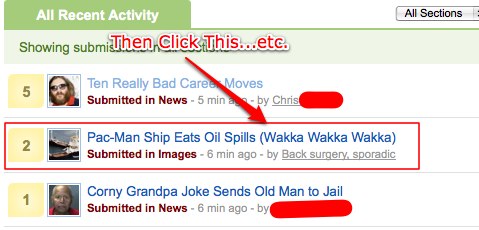
If you have 80-100 friends, starting off this process should take you 15-20 minutes to complete each time you login. I recommend that you login at least 3 times per day. Once in the morning, once mid day, and once in the evening to make sure you don’t let the submissions back you up too much.
SIDENOTE: One thing to keep in mind as you do this is that you have 24 hours to digg your friends’ submissions before your opportunity to digg them ends. If you are one who diggs your friends’ submissions after 24 hours they won’t be adding you as a mutual friend and if you were a mutual friend they will be dropping you faster than white on rice. So be sure to allocate certain times during each and every day to make sure you always stay on top of your friends’ submissions so they continually stay on yours. As with all social media this is an “I help you, you help me” type of community and as long as you stay committed to this, you should be golden long term.”
SIDENOTE: Don’t submit any stories until you follow Part 3 of this guide. You will see why in a moment. Again just stick with me and stay the course. If you are wondering how long until you submit a story…it will take doing this specific activity for at least 2 months before you will ever submit a story because specific things have to be in place for your first submission to have even a remote chance of getting to the home page…more on that later though.
Commenting
As you are following these exact steps above religiously each and every day you may come across stories that may strike you to write something in response to the content. This is a very smart thing to do because if your comment gets “dugg up”, it yields to even more exposure and an increase in your personal profile views and fan base count.
Commenting is very easy…
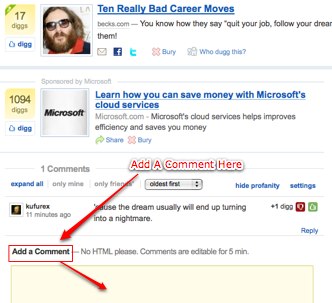
After you leave your comment, you only have a small amount of time to change it. If you are a blogger and familiar with managing comments already, this process is similar.
Not much more to say here other than letting you know that the funnier and/or wittier your comment is, the more play it will get and more diggs it will get over the long term. This is good for you because if your comment gets a ton of diggs…that just means more exposure for you.
Before placing your comment, be sure to see what other diggers are writing and see if you can model your comments as such to generate the most success.
Managing Your Friend List and Mutual Friend List
So you are probably sitting there thinking…OK, Scott, how do diggers know if I am digging them or not, and how do they do this?
That is a great question, and it comes with a simple answer!
Enter FriendStatistics.com
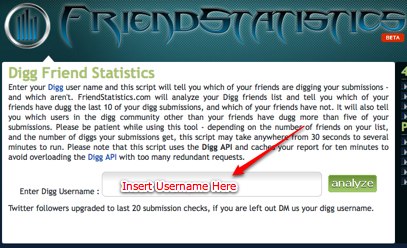
FriendStatistics.com will become your best friend when it comes to managing your friends’ list once you start building a powerful profile on digg. The reason the tool is so powerful is because the tool shows you:
- Who is digging your submissions
- What stories your friends/followers have dugg
- How many stories each individual friend has dugg within the past 24 hour period
- How many stories each individual friend has dugg outside the past 24 hour period
- Who isn’t digging your stories that is a friend (deadbeat)
- What stories have gone popular of your last 10 submissions
- What stories are still sitting in the upcoming section
SPECIAL NOTE: A “follower” is someone who is digging your stuff religiously, but who you haven’t added as a friend yet
SPECIAL NOTE: A “deadbeat” is someone who you have as a friend or mutual friend who hasn’t dugg your last 10 submissions
Every single top digger that I know and network with uses this tool once every week or once every two weeks to continually add new loyal friends, and drop those who aren’t digging their stories.
The fact is this, without this tool there is no easy way of really knowing who is digging your stories…unless you had 100 hours per day to look through all of the stuff you digg.
This tool makes it incredibly easy to manage and sort your friends to build a thriving and raving fan base that will take care of you moving forward.
Now so to answer your question…
Because each and every top active digger uses this tool, and after you have stayed loyal to them digging their stuff, they will eventually add you as a friend as long as you stay loyal because this tool shows who is working and who isn’t.
The process of adding you as a friend may take anywhere from 1-2 months depending upon how often each digger checks their friend statistics using this tool.
The bottom line is…for the most part, if you stay active and on top of all of your friends submissions, more often than not they will add you back…and if they don’t after 2 or 3 months, you can easily drop them as a friend and find others.
Building + Nurturing Your Underground Instant Message Digg Network
As you continue to build your influence and profile within the digg community, it is important to also keep your instant messenger open during the day so you can capture new people in your digg network to meet, leverage, and help each other out.
It is for this reason why I encouraged you to insert your instant message name into your profile when setting it up. By putting your screen name there, it is an open invitation for people to reach out to you and connect. I would recommend that you make it the same as your digg username for obvious reasons.
People will contact you randomly during the day through IM, and it is always a good thing! Be sure to add them to a specific part of your buddy list so in the future if you have to ask them for help with something, you know where to find them.
I also encourage you to reach out to other digg friends you have added through IM to introduce yourself. Be you, be real, and most importantly, be nice. If you are cool the digger will add you to their buddy list and treat you as good as you are treating them.
Again remember…this is a win/win relationship you are building here. You help them, and they help you…having an underground digg IM list is essential to digg success.
SIDENOTE: I have met some of the nicest people on digg through this method. Not only have they helped me get votes on story’s but more so, I have done business with people because of the networks I have built.
SIDENOTE: You would be doing yourself a disservice if you didn’t take advantage of putting your screen name in your digg profile. What you will find is that most of the people who build their digg networks in their “underground instant message digg list” also are people who are active on other social media sites and who can help you get exposure on those as well…not just digg!
So there you have it. That is the exact activity I do each and every day to build a powerful profile on digg, so when I submit an article into the site, I have built the necessary mutual connections who will digg my stuff…and thus pushing it to the front page of the site.
Note: Everything I submit doesn’t always hit the front page…for a myriad of reasons that I don’t know. It is a combination of the digg algorithm + other factors affecting the story submitted. Bottom line…knowing that it works and has proven to work should help you take the necessary activity to leverage this site.
YES…it takes work
YES…you have to pay your dues
YES…you have to stay active and committed
And YES…that does suck!
BUT!
Imagine putting in the time, building the connections, digging your friends’ stuff and then submitting your blog site at 9pm on Monday night into digg.com…
You wake up Tuesday morning, and your site is sitting there on the front page of digg. Your heart begins to race, and you practically want to dance around the house knowing how much traffic and backlinks it is getting to that specific piece of valuable content.
With that in mind…don’t you think it is worth all the time and energy to do it?
I think so to…
Ok, so now you are ready to move to the next step of “popping your digg.com frontpage cherry” (NOT your site) and the next section of this guide will show you how to do that since you have been actively building your profile to handle the new submissions!
Part 3: The Exact Process and Knowledge You Need To Know To Get A Piece Of Content To The Front Page Of Digg.com
Once you “pop your first digg cherry” it feels INCREDIBLE! The feeling of getting something to the front page of digg NEVER gets old. Not only is it exciting knowing that a massive amount of people are seeing the piece of content, but even more so, it is fun to read the comments for each article that makes it to the front page. Digg comments are one of the best parts of the site for entertainment purposes, and can be the source of some enjoyment with other online friends after sharing the comments with them.
The Exact Pieces in Your Profile That Need to be in Place Before Submitting Your First Story
1. Have at Least 100 Mutual Friends
You don’t want to submit a piece of content into digg without at least 100 mutual friends. You want to make sure that you have enough mutual friends that will see your submission, and therefore can digg it relatively quickly after glancing at it.
(Remember the top diggers are doing exactly what I am teaching you here so it goes both ways for you and your mutual friends)
The more mutual friends that you have before you submit stories/articles/content, the easier it is to push stuff to the front page. Don’t submit until you have 100 mutual friends. You won’t regret taking the time to build this before submitting your first story; trust me!
2. You Have Dugg 2,000-5,000+ stories
Aside from building up 100 mutual friends, you should have by now dugg anywhere from 2,000-5,000 stories depending on how fast your friends added you back as a mutual. This isn’t exact, but more so a ballpark to keep in mind so you can gauge your effectiveness in building your network on digg. You can add mutual friends faster if you strategically reach out to them through instant messaging. Again, be yourself and be real, and they will more than likely add you back.
3. You Have a Story to Submit that ISN’T Your Blog Article
This is crucial…you want your first couple stories that you submit into digg to be stories from the popular URLs on digg that aren’t your website. You can find the most popular URLs on digg by using the tool described toward the beginning of this guide…di66.net. Select a story that works for you, and then submit it into the site using the step-by-step process below.
SPECIAL NOTE: If you just submit your own personal site without submitting other high quality content from other sources, most top diggers will get annoyed. Finding a balance between submitting your site, and other good content sites is important. Don’t ever forget this special note!
SPECIAL NOTE: If you try and submit a story that has already been submitted, the Digg website will notify you. In this instance, be sure to find another story to submit so you don’t get banned for a duplicate submission.
What Content Should I Submit for My First Story?
Knowing what content will and won’t hit the front page is an art in and of itself. As a digger subbing stories to the site that you want to hit, you must understand everything in this guide, continually scan the front page to learn what is popular, read the comments of diggers to see what backgrounds they are coming from, and also think about what is going on in the world at the instant you submit the story.
When it comes to submitting your first story to digg, I would recommend that you go to a mainstream content site that is listed at di66.net. Once you find a source site, you want to submit your article from you, then follow the same process below.
But before that, I must cover something with you that will increase your chances of getting something to the front page.
SPECIAL NOTE: There are many types of content that go popular on digg ranging from funny pictures, hilarious video clips or articles, technology news, top 10 list posts, interesting articles about particular topics, infographics, economic and political articles, business articles, and mainstream + pop culture news. When finding something to submit to digg, make sure that it fits into one of these categories for the optimal success.
Who is the Digg Audience, and What Type of Content do They Like?
Before you find and submit content into digg, you need to first think about who the digg audience is and what they really like.
Based on my experience on the site since August of 2009, I have noticed a few trends in the type of users of the site.
- The majority of them tend to lean more left of center on the political spectrum
- They are passionate about liberal issues such as green energy, sustainability etc.
- Males are the primary demographic on the site
- Users are pretty computer savvy and are techies as well
- My guess would be that the ages range from 15-50
- They love to laugh and joke about funny things on the internet and are incredibly witty
The reason knowing this is important is because when you know who your market is and what it primarily wants, creating and finding content that will suit them becomes easier and easier.
With all of this in mind, create and find content that you feel will serve this market well. Also if you are stuck, be sure to check out the front page from time to time as this will show you the trend of what people like and don’t like.
Again there is no exact “how to” with choosing the best content to submit. It is more “feel” over “step-by-step structure.” As you get used to the site, you will learn more and more what works best for you.
The Step-by-Step Process You Must Take When Submitting Your First Story
OK, so you found something to submit! Now is the time to send it into the digg universe. Here is the technical step-by-step screen shots for you to follow + what to keep in mind as you get ready to pop your “digg cherry.”

Once you are there, then fill in the URL for the story, then select if it is an article, picture, or video.
After completing that, the next step is to fill out the headline and description for the particular story. This is a very crucial part because the headline is by far one of the most important steps of the process after finding the article.
Most of the time I use the headline of the story that I am using, but other times I customize it to make it more compelling. The more compelling you make the headline, the more clicks it will get, and the more diggs and exposure it will get.
Again this is more “feel” over “technical know how” so experiment with it.
I would suggest that you just use the headline of the article you are submitting for your first submission to keep things simple.
QUICK TIP: One way to increase the click-throughs of your headline is to add the tags [pic] or [vid] to it so you are more clear about what is on the other side of the link. This definitely makes a big difference and is something the top diggers have learned in the past.
Once you figure out your headline, then it is time to create the description for the article. Ideally, what I typically do is go to the article and take maybe 2-3 sentences from the article, and copy and paste them into the description field. Other times I make a more compelling three-word sentence depending on the type of content that I am submitting.
Again this is more “feel” over “technical know how” so please experiment with it. For your first article that you submit, just use a 2-3 sentence paragraph out of the article you are submitting.
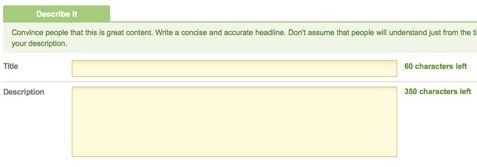
After filling out the headline and description for the story, it is time to select an image. If it is a news story, I would suggest that you select an appropriate image. Realize that sometimes an image isn’t necessary, and again you have to play this one by ear depending on what your choices are when submitting your article.
Experiment with things, but be sure that whatever you do, it is relevant to the story.
Next, it is time to choose the appropriate category for your story. This is pretty self-explanatory. Choosing an appropriate category is also essential because if your content isn’t relevant to the category that is selected for it, you run the risk of it getting buried and never hitting the front page in the 24-hour period.
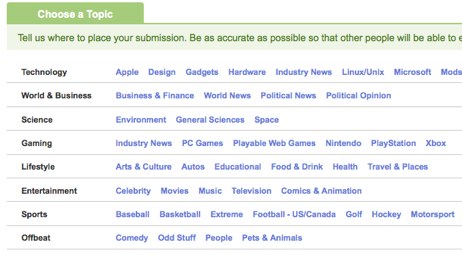
After that fill, out the CAPTCHA, make sure the story is alright, then press submit!

Once you press submit, it will drop you to the main page with the story. Once I am here I typically add it as one of my favorites so it shows up at the top of my profile for casual visitors to my profile to see it so they can digg it.

Here is where it ends up in my profile after I favorite the story:

That is it! You have just submitted your first story to digg! Congratulations!
What Should I Do After Submitting My Story to Increase it’s Chances of Popping?
After submitting your story to digg, there are a myriad of things you can do to increase the chances of getting your story to the front page. While there are many different opinions about this, here is what I typically do.
Because I have built up a massive amount of really good digg mutuals and fans, I pretty much just let the story sit and let my mutual friends hit it. I only ask for instant message votes if it hasn’t hit after 7 hours of being submitted.
Because I will naturally get votes upon submitting it, I more often than not, let it sit and only push it if I absolutely have to.
While you could naturally tweet and instant message your digg friends for votes, I rarely do this now because I have built up such a powerful base of friends, and I treat them like gold hitting every single one of their submissions (except when I am on vacation).
SPECIAL NOTE: One thing digg allows you to do is create what is called a “digg bar link” as seen below. This gives you the freedom to use this link to send to friends through e-mail + IM, tweet to your followers, and share in your facebook feed to generate more digg votes. This increases your chances on getting to the front page, and also gives you an easier way to share your submitted story with your network. You can get your diggbar link by clicking any story within digg. You know you are in a diggbar link when your screen looks like this…
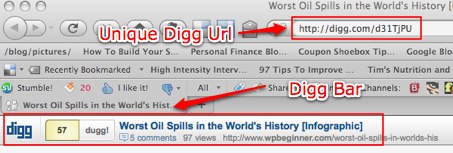
If you are starting out, I would suggest that you probably push it a little more aggressively up front to your digg instant message list…and then once you have built a solid foundation for future stories, just submit, and let it sit.
One thing that most people don’t know is that if your story gets too many diggs too fast it will trip up the digg algorithm, and your story will never hit the front page.
Balancing the entire process is a true art and again takes more “feel” over “technical know how.”
SPECIAL NOTE: One thing to understand about digg’s website is that they have what is called the recommendation engine. This part of the site shows you content you may like based on your previous digging history. After you submit your story into digg, it will show up in the recommendation engine of other diggers that are logged in. This is a place where you will expose the story and your profile to new digg users to find you and add you as a friend. This is also a place where digg users will be able to digg your story. Keeping this in mind is also important as it is one of the main moving parts to the site as well. If your story falls out of the recommendation engine, your story won’t hit the front page. You have no control over this.

What the Heck is This Digg Algorithm You Keep Talking About?
Great question! Unfortunately, there isn’t a simple answer for this, but I will do my best to explain it.
Each and every day there are thousands of stories submitted into digg.com. Many of them don’t get promoted to the front page. From what I know only about 130-140’ish stories get promoted to the front page on any given day. The thing that determines what gets promoted and what doesn’t is the digg algorithm.
The digg algorithm is the decision engine that determines what gets promoted and what doesn’t, and there are many factors that affect the algorithm. Digg is constantly changing this algorithm, and never ever shares how the digg algorithm is structured.
Here is what I know…the digg algorithm decides when a story should or shouldn’t be promoted by taking these things into account.
- The URL of the website that was submitted…and the history of the domain on the site
- History of submitter
- The amount of buries the story gets
- Total amount of diggs the story gets
- The amount of diggs per hour on the story
- The amount of time the submission is/was sitting in the upcoming section of the site
- The diversity of diggs for that particular submitter and story that was submitted (Who is digging….fans / mutual friends / organic diggs)
There are probably many other factors that affect the algorithm. Even though that may be the case, I know for a fact these factors definitely affect the algorithm.
What I can tell you is this, if you follow exactly what is in this guide, you shouldn’t have to worry about anything. Just continue to do the same activity, and you will see the results you are looking for. If you try to make this site, and your activity way to complex…you are bound to spin your wheels and not get anywhere.
If I can say just one thing to you…
As long as you always remain active, always find/create the best content, submit regularly, be real and do the necessary activities each and every day, the more success you will see from this.
Just stay focused on doing the necessary activity, and it will work for you.
Why do you Generate More Fans Once You Hit the Front Page with Your Story?
After your story hits the front page, you as the submitter get the benefits of this exposure through a variety of ways.
- You give the digg community the opportunity to click over to your profile which then increases the chances they will add you as a friend + add you to their IM list.
- Your popularity ratio on the site increases…which is a measure of influence on the site
- You become more recognized in the community as someone who always finds really good content to share with their digg network
…All of this leads to more leverage for you down the road so when you submit your own site to digg, it increases the chances that it will hit for you. Just make sure that you have everything set upon your site before you do this. We will cover this in the next section in more detail.
SPECIAL NOTE: When you increase your fan numbers that begins the process for you of seeing if they are serious fans, or just tire kickers. Ideally you want to have every single one of your mutual friends to digg every single one of your stories. They must become a fan first to make this process happen. Because you can use friendstatistics.com you can easily track what fans are paying attention and what ones aren’t. If they are a fan who is digging the majority of your stories you can then add them as a mutual friend. Taking someone from fan to mutual takes time…but once you have a mutual friend…they will stay a mutual friend who diggs your stories over and over again. Keeping this in mind is important because it gives you more leverage over the period of time while you are using the site!
When Can I Submit My Own Site, What Needs to Be Done, And What Else Do I Need To Know Before Taking This Specific Action?
Ok, so by now you have been active on digg for awhile. You have gotten anywhere from 5-10 stories on the front page of the site. Your fan base and digg network is growing, and now you are thinking that you want to try a crack at getting your own site to the front page of digg.
Before you submit your main homepage url (which you should NEVER do), please read this section. This is by far one of the most important sections in the entire guide. If you ignore this section, your chances of ever getting to the front page of the site will be done for if you don’t follow this advice to the T.
Here we go :-)
What You Need To Know and Implement Before Submitting Your Site To Digg.com
1. Get a blog installed on your site.
The first step to get your site ready before you submit it into digg is to give yourself a way to publish and manage content through your site. For you to submit your site, you need a place to create the articles and content that is worth submitting into the digg.com engine. Submitting just your www.domain.com url is meaningless and will get you buried and banned from the site very quickly.
Be sure that when you go to your web guy, you tell tell them to install a blog into your site using the wordpress open source software. If you need help with this please contact me. Setting up the blog goes beyond the scope of this guide so be sure to get your web guy to do it for you.
2. Set up your blog correctly so it is social media friendly for the digg audience and other social bookmarking sites with various plugins and widgets.
Once you have your blog created, it is now the time to build the framework and structure within the site to serve your site’s goals. Again this goes beyond the scope of this guide, but if you need help with this please contact me as I can directly help you with this. All you need to know is how to set up your sidebar with the appropriate widgets and plug-ins necessary depending on your goal for your site. This will differ for each individual person depending on their business. This also includes your post’s structure and flow as well.
3) You need the WP-Cache plugin installed in your blog so your site doesn’t crash when it hits the front page.
As stated before in the earlier part of this guide, it is essential that you have a caching plugin on your site so when your site hits the home page, the massive influx of traffic doesn’t completely crash it. This is a specific plugin you must download through wordpress plugins directory.
4) You need to know how to structure and create content in a way that works for sites like this…this is a true art within itself.
After you get your site and framework handled, the next and step is knowing how to create content that is digg friendly and which also has a high likelihood of getting to the front page after it has been submitted. If the content you are creating doesn’t fill the bill…everything else in this guide is meaningless for you when it comes to getting your personal site to the front page. If you need help creating high value content, please contact me as I can directly help you with this.
Part 4: You Hit Your Website On The Front Page of Digg.com. Here Is How To Leverage The Exposure
When your website hits the frontpage of digg.com, you will remember that day and time forever. Getting your piece of content to the front page of digg is quite the accomplishment as you are one of only 140’ish stories that hit each and every day. The traffic to your site goes through the roof. A slew of Retweets and Facebook shares ensue, and you really are well on your way to internet domination.
But for you to fully experience all the benefits of this happening to you, you must know a few key things about what it takes to fully maximize the exposure that you receive once your blog hits the front page of this amazing website.
How to Maximize Digg Traffic
What you should know beforehand is that the majority of the traffic that you receive from digg won’t convert as you think it would. Many of the visitors coming to digg go to your site, look at the article, and then click off without exploring your site further…unless it is really compelling and set up in a compelling sticky way. The average bounce rate for digg traffic on your site will be around 95%, and the maximum amount of time the majority of them will stay will be about 30 seconds max depending on the piece of content.
Instead of viewing the digg traffic as the main focus, it is important to realize that this initial traffic surge should be leveraged. There are specific ways to do this to fully maximize the exposure you will receive after your story hits the front page.
If you think of your digg traffic as the starting point to the post going viral…and treat it as such by giving your new digg visitors a way to push it out to their networks easily and efficiently, you will reap all the rewards of a digg front page.
As described earlier, once your website hits the front page, you will automatically get traffic from two specific sources. Those two sources are digg.com and content aggregation sites that automatically pull content from digg. A content aggregation site example would be a site like jimmyr.com or popurls.com.
Once you realize this, your next challenge is to figure out how to continually create that viral social media exposure from these two sources of traffic that are being generated simultaneously once your story hits.
To fully get the most from the traffic from both of these sources, you must install these specific buttons in some way, shape, or form on each individual blog post

Most of the time these buttons are created by using the plugin in wordpress called “digg digg.”
Once you set these buttons up on your individual blog, then you are pretty much set to fully leverage the traffic that is generated from digg.
If you can visualize what happens when you start putting this all together, this is the process and flow that your content goes through.
I. Massive traffic from digg.com and aggregation sites
II. The traffic then reads the article and then decides if it wants to share it in facebook or twitter or thumb it up on stumbleupon…or even submit it to another social bookmarking site
III. The user decides what they want to do and takes the action sending the piece of content to their networks through twitter, facebook, or any other place they can share it
IV. After sharing it with their networks, their networks come to the blog post and consume the content. Then they have the same choice to share or not to share.
V. Once you get 3rd, 4th, and 5th, generation traffic coming to the post because people are consistently sharing it within social media…you have hit a viral homerun and the thing is there is nothing you can do to stop it
VI. You may even get lucky in the process of all this viral traffic being created that a major news site/content site picks it up and gives you a direct link to your content. As you know, the more links you get to your content the better rankings you will get in google. If the links are from sites with a pagerank of 6+ or more according to google, you will be golden. (I know because this happened to me from one of my posts that still is getting traffic well after it has hit the front page of digg)
VII. As stated above, it is at this point where you have “lost control of your content”, and you get to sit back and enjoy watching the analytics pile up as you relish in the security of knowing how many backlinks you are generating, how much exposure you are getting, and how this is one of many posts that will hit the front page after you have set up everything correctly from the get go when it comes to leveraging digg.
Now one other piece of the puzzle when it comes to the traffic part is that once your piece of content hits the digg front page, your challenge is to stay there because the community determines if you stay or are buried off the front page. This is where the quality of content you create becomes so important.
If you create crappy content and/or content that doesn’t agree with the audience, once it hits the front page, it will be “buried off the page” due to it being something that the community doesn’t like. There is nothing you can do about this fact. The only other way to combat it is to produce content that the community likes. If you need help with this, please contact me. I can definitely help you with this. Even though your story may be buried off the page, you will still stay on the content aggregation sites, so all will not be lost; you just won’t experience the full benefit of staying on the digg front page.
Now…
There is a powerful thing that happens in digg when you really get your site to fly…
The Powerful Process Of Popular Content Within Digg’s Website
Once your content hits the front page, this is step 1 of the digg front page journey. You will get anywhere from 10,000-15,000 visits over a 24-hour period, and if your story is average you will get anywhere from 250-350+ diggs. These statistics are typical for most stories that hit the front page every day.
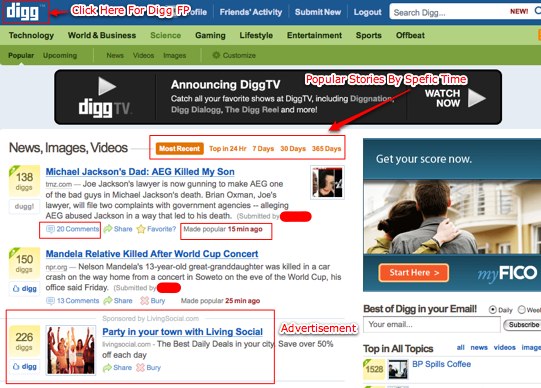
If you are lucky, something really powerful happens within digg if you get more than the average amount of diggs for each story that you pop. Pretty much if you generate over 1,000+ diggs or more, you go into what is called the “TOP” section.
In the top section, it aggregates content by the number of diggs over a period of time.
Imagine it as a place where the cream has risen to the top, and where they aggregate the content within the digg.com website into specific categories.
The specific categories for what I am talking within the website are:
Top in 24 hours
Top in 7 days
Top in 30 days
Top in 365 days
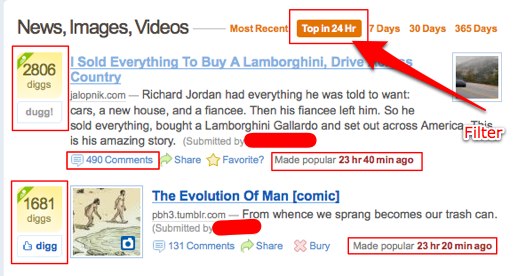
Ideally, if you generate a large amount of diggs in an extremely short amount of time, you will be the top of 24 hours and top of 7 days, no problem.
Top in 30 days would be a push and top in 365 days would be nearly impossible.
Here is why that is important to keep in mind…
Once you get your digg front page, you will get the initial surge of traffic from those visiting the home page and clicking on your story. A certain percentage of those visiting will digg your story.
After maybe 1-2 hours, depending on the amount of diggs you get, will determine if your story really catches fire in the digg community.
What I can tell you is…if your story has more than 500 diggs before it goes to the second page of the digg popular section, you have a very high likelihood that your story will go top in 24 hours.
Once that happens this gives you a substantial advantage compared to the other content on the site…Here’s why…Let’s say that your content hits the front page at 8AM EST and gets 800 diggs. Then let’s say that John goes to the site at 12PM EST and doesn’t see it on the home page…but instead wants to see what is popular throughout the day so he presses the Top In 24 Hour Button where your story is.
It is there where he can find your blog post and click on it.
If you can visualize this happening throughout the day, if you get enough diggs within the website, and have set up the content appropriately to foster this activity outside of the website with all of the incoming traffic coming to it…you will fully leverage the traffic to create the greatest opportunity and chance of getting to the top of the “Top In X” sections.
This creates an entire second wave of traffic that then continues being pushed through your site without being able to fully control what is going on…You just sit back and pray that your servers hold up.
The best image I can give for you in the big picture is to visualize a snowball rolling down a hill. At the top of the hill, it starts off as a little snowball, and then after hitting the digg front page, due to all of the momentum that you have created…the traffic builds and builds and builds exponentially as it continually is passed around through the social media channels, and is linked on high profile websites if it is good enough.
Every new share, link, or digg visitor becomes another opportunity to “spread the virus” as most marketers would say.
This is extremely powerful…and is exactly what happened to the piece of content that I showed the traffic numbers in the beginning for. Over a 30-day period, the piece of content generated 400,000+ visitors and was everywhere! If you want to know what piece of content it was, just send me a message and I will share it with you.
The bottom line is that once you understand all of these moving parts to the website and how they interact with other social media sites…you can set up your piece of content to be conducive to achieving your goal in your niche. It is a wild ride and incredibly exciting once it all works out for you!
Turning The Traffic Into Money
While this guide isn’t fully dedicated to showing you how to make money with digg…I am going to dedicate a small portion of the guide to this.
Bottom line: there are three distinctive ways to monetize this traffic. You can monetize the traffic by putting google adsense on your site, selling advertising on the site, and leveraging the traffic for social media exposure for your company and your products.
You just have to understand that if you think you are going to submit a product page on your website and it will hit…you have another thing coming.
In fully leveraging a site like digg and other social bookmarking sites, you must understand that you have to find creative ways to integrate your products and links to products in the content without making it seem like you have a hidden agenda. The more transparency you put out, the greater value and feedback you will get from all parties involved that are consuming your content.
If you produce kick ass content, the audiences will trust you and will naturally want to know more about your products anyway…and when you continually show up, there is no way they are not going to see who you are, what you offer, and how you can help them.
As in all social media, you must give first before receiving anything. The optimal way to do this is by producing the amazing content that serves your niche. Once you produce the content, you can then push it out using digg and many other social bookmarking tools.
Now I know this guide is considerably long, but I want to clue you into some other unknown stuff about digg before closing up this guide.
Part 5: The “Other Unknown” Stuff About Digg’s Website, Culture and Community
As with any website, there are specific moving parts within the site that are somewhat unknown by most casual everyday visitors. In this section, I will cover them briefly just to give you the 411, so when you start participating in the community, you will look like an expert from day one.
RSS Stories To Google Reader
Within digg if you like to receive information from a given category or part of the site, you have the option to download the RSS feed that will feed you the content automatically.
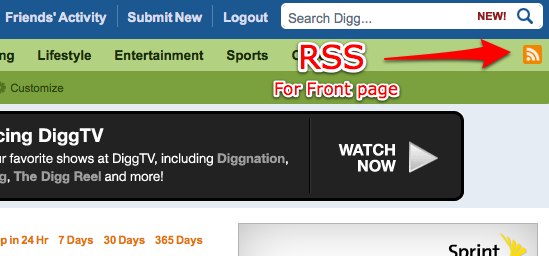
In the image above, I am highlighting the RSS feed for all popular stories that hit the front page. While this would be a good one to subscribe to, you can do this same thing for specific categories within the site. E.g. Technology
I like to use these RSS feeds to stay on top of certain niches or keywords that I am focusing on for clients or for myself.
You can also set up to get RSS feeds for specific search words that crop up within the site. E.g. iPhone
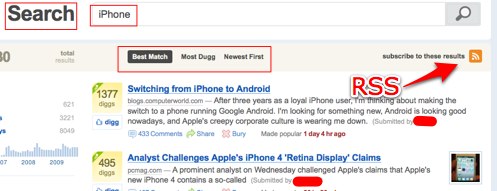
Use this as you will…There are many ways to use this to help you find really great content to share with your networks over time.
Hot and Cold Streaks
One thing to know about digg is that as an active community member you will experience hot and cold streaks when it comes to submitting stories and hitting the front page. The first couple front pages will be cake, but after that, there will be times where you wonder if digg has something against you…I like to call those times “The algo hates me, but I am going to push through it anyway.”
Knowing this going in will help you deal with the specific challenges that will face you as you continually use the site to share and find the best content on the web.
Protecting Your Content
Be sure that if you submit any picture or video that it has a watermark of some sort in the content so if it gets stolen (which it will) and is used on another website, people know you were the source of the video/picture etc.
This happened to me when I hit one of my personal videos on the front page of digg. After hitting, it was ripped all over hell and creation and I had no control whatsoever to let people know it was from me. The video has probably gotten 2,000,000+ views and counting as of this writing, and it was just insane.
If you want to see the video that hit, please let me know, and I will send it to you.
Just protect your content at all cost, don’t forget to put a watermark or some identifiable logo on it just to cover your ass.
The Unspoken Rules Of Digg
- Know what content to submit and what content to stay away from. Anything internet marketing or SEO related is something that you should stay away from at all cost. The digg audience hates anything having to deal with internet marketing or SEO related.
- Remember that most diggers follow the “I digg you, you digg me” way of using the site. So don’t ever lose sight of that, and use friendstatistics.com to monitor the activity of your friends.
- The best comments that get the most attention are the ones that are funny/snarky or good long content. You will learn over time seeing how the community reacts to certain pieces of content. The more you watch, the more you learn, but don’t forget to still take action.
- Don’t bury a story unless it is 100% spam or SEO/Internet marketing related.
- There are a few digg memes that are extremely prevalent on the site. One of them has anything to deal with bacon. The digg audience LOVES bacon and will talk about it any chance they get in content they create, or in comments. Another meme is that “Nickleback Sucks.” They don’t like this band. Never say you are a fan of them. A couple others that pop up from time to time are a picture of a guy doing a facepalm + a picture of a pedo-bear on stories with kids. There is also the occasional star wars character that is thrown in every now and then. It is really a hoot when you follow the comments seeing these pop up over and over again.
- Digg does have the power to ban a website from being submitted if the community construes it as spam. The best thing you can do if this happens to you is to contact digg by sending an e-mail to support@digg.com.
- When you submit your site, don’t have pop-ups or pop-unders, it annoys the audience and will increase your chances of your site being banned
- The earlier you comment on the stories, the better chances that you have of leveraging that exposure to your profile
- Each story has approximately 24 hours to go popular. Most of the time this is true but there are very rare instances where this rule is broken.
- You can only have one digg account…if you have more than one you will be banned from the site.
- All other questions and answers about using the site are in the FAQ and TOS.
- The best time to submit content is either late at night or early in the morning. When you submit it during the mid-day, it kind of gets lost in the shuffle.
The Wrap Up (10 Step Process)
So to keep this process simple. Here is a breakdown of everything in this guide:
- Create your profile, and understand the moving parts of the site
- Add the friends, and digg their stuff religiously (Set times each day for this)
- Once you hit a point of having a firm foundation with friends and mutual friends, then it is time to submit your first story (Not your blog)
- After you submit other stories that successfully get to the home page, then it is time to start submitting your stuff amid the other content you have been submitting
- Create a blog, and make sure it is set up properly on your site
- Create the best content possible on that blog that is digg friendly and serves your niche
- Submit the story, sit back, and watch the movie play
- Never forget the rules of the site that are not written anywhere and always stay active and participate in the many conversations that go on the site
- Generate a ton of backlinks and social media exposure
- Dominate your niche one blog post at a time.
Thats All Folks!
P.S. Just want to give you a heads up that digg.com will be changing in the future. Once the changes hit, I will update this guide and let you know about it in a future post!
P.P.S. Here is the PDF Guide of this blog post that I promised you at the top. (The PDF file will automatically download once you click the link) please contact me if you have any problems.
May I Suggest...
Read More Articles
Free Productivity Training
- How To Make More Sales and Keep More Profit in Your Business
- How To Create A Social Media Strategy: For Companies Who Already Have A Customer Base
- How To Position Your Product Effectively in The Marketplace (Just Answer These Three Key Questions)
- The 15 Questions You Must Know the Answer To Before Creating An Effective Marketing Campaign
- 3 Reasons Why Having A Content Strategy is Essential For Your Blog and Your Business






{ 20 comments… read them below or add one }
This post deserves to be #1 on Digg! I will have to finish reading it later.
Thanks Dan for your comment!
Wow! Thanks for saving me the cost of buying the book, Scott. ;-) Lots of good, useful information here about how to get noticed by Digg — that is easy to follow. Let’s see if it makes it to the front page of Digg!
Jennifer,
You are so welcome it is my pleasure!
packed full of information here…Take the time and anybody can be successful if they follow this. But its a ton of time!!
Joe,
You got that right. Lots of time, but it is worth every minute you invest!
by the way… lets see a gravatar already :)
Scott,
Great post full of solid information from someone who has obviously done it, not just read about someone who’s done it.
Doug
Thanks Doug! Appreciate it!
Scott This is really a complete and useful guide thanks a lot, and thanks alot for making it in PDF to save for later
Hiomida-You are so welcome. So glad you found this post useful!
That is a great article. I have used Digg But Not gone in too depth with it. But need to start adding more friends on there and doing more. Great Tips.
So glad you enjoyed the article Chris! Keep me updated on your progress!
All I can say is “Wow”. I think you really over-delivered with this report. I like how you describe the exact process to leverage Digg and also why Digg is so powerful. Great stuff!
Amazing, amazing post. I have been wondering how in the world to start to tackle Digg. There is so much value here it’s incredible! Thanks so much for the pdf, downloaded with no problems and I can’t wait to get to read through it all. Scott Manesis sent this my way and I can’t wait to thank him again.
Staci
great read! I’ve gotten close before, but I never had enough to get to the front page!
Meeting you and your website AND This article couldn’t be more timely!
Thank you so much!
I am excited to get started with this.
El
How can I post a link to my site on Digg if I don’t have a blog? The site is http://www.listburn.com
It’s a newer site that competes with Craigslist, but it keeps a lot of the spam type ads out and is nicely laid out while searching. Filters adult content and has safe meeting locations submitted by the users.
Steve –
Thanks for the comment! Unfortunately you wouldn’t be able to because it would have to be a valuable piece of content that you would contribute to the community.
You could always buy advertising though.
Thanks a lot for great step-by-step guide!
Do they change their algorithm often? Does this guide still stand nowadays?